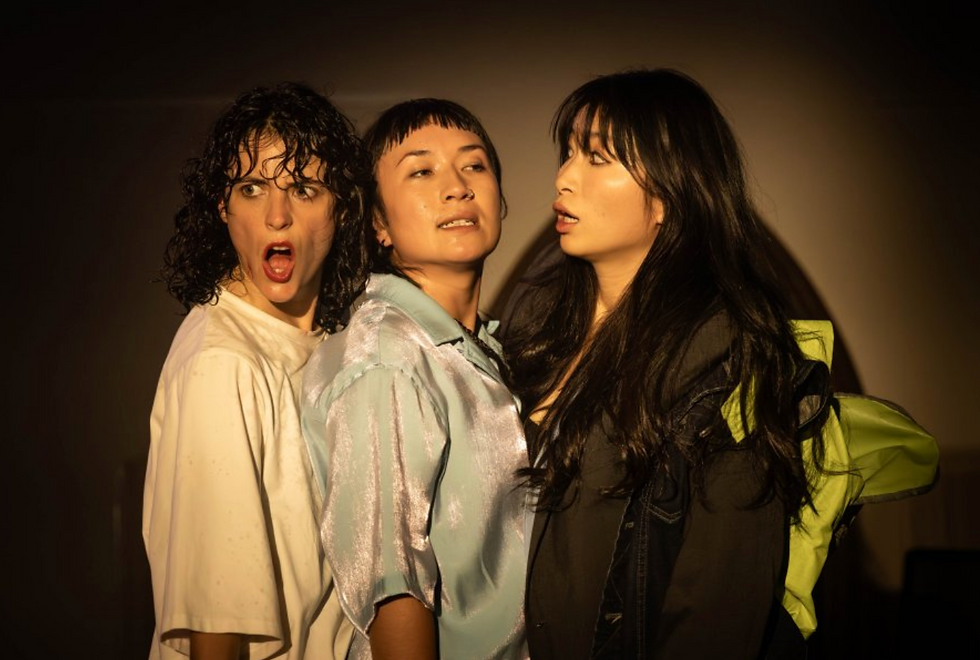Review: My Sister Feather at La Mama Courthouse
- Theatre Travels

- Mar 12, 2023
- 3 min read
Review by Lucy Lucas
The second part of Liv Satchell’s Grief Trilogy, My Sister Feather is a masterfully realised exploration of loss, trauma and memory. Developed over nearly a decade, and nominated for a multitude of awards, the trilogy is currently being produced for the first time in its entirety at La Mama Theatre.
The premise is simple; two sisters, Tilly and Egg, reunite at the news of their mother’s death. One is incarcerated, but both are held captive by their pasts. Abandoned as children they have dealt with the lingering scars of trauma in different ways, fuelling endless pain, resentment, and disconnection between them. Allowed by an invisible oppressive power a tense, yet highly observed meeting on compassionate grounds they simultaneously yearn for their past closeness and powerfully reject each other’s attempts at reconciliation.
Only the most essential context is shared, much is left untold. We never discover exactly why Egg is in prison, nor do we know much about Tilly’s life outside her work. There is a judiciousness in Satchell’s script, she and her team have zeroed in on the story in its purest form and this economy of detail means we never stray far from the essential themes of loss, disconnection and regret. At times incredibly funny, Satchell’s script alternates between brutally tense minimalism and simple yet powerful poetry. In just eighty minutes we run the gamut of intensity and I am left both satisfied and emotionally spent. In a recent interview with The Saturday Paper Satchell spoke lovingly of Pina Bausch’s great work Café Müller, describing it as ‘hinging between brutality and tenderness’. Whether meaning to or not this is something My Sister Feather does too, placing pain and love, distance and intimacy alongside one another and demonstrating their impossible symbiosis. Flashbacks occur but remain grounded in the space, the way memories and auras of past relationships float within and inform the present moment. And even with these time jumps the play never strays into sentimentality or whimsy, holding us tightly and firmly spellbound every step of the way.
My own experience of grief is inextricably intertwined with the rest of my life; laughter sits alongside sadness and love jostles with regret. Satchell’s script explores grief from a place of truth and visceral, lived-in understanding. There is no guessing here, as an audience you feel you are watching something genuinely experienced rather than written about.
Credited as both actors and co-writers, Belinda McClory and Emily Tomlins give entirely grounded, masterful performances. Their characters enter fully realised, so deeply inhabited their unspoken history is evident in every sideways glance or shift of weight. McClory is a powerhouse of neurotic and agitated energy, never letting the ball drop for a moment. It is a somewhat icky phrase but Tomlins is the one of the most watchable performers I have ever encountered. Her performance is a delightful clutch of paradoxes; extreme expressiveness and subtlety of movement choices, total commitment and complete ease. The scenes in which her and McClory play their characters as children are viscerally joyful and blisteringly bittersweet.
So far the whole trilogy has taken place in slightly institutional, publicly transitional locations; part one in a swimming pool changing room and now part two in a prison visiting space. Lockers, benches, a vending machine – James Lew’s simple yet highly specific design conjures the familiar signposts of spaces both communal and cold. This is the first show I have ever seen at La Mama Courthouse in traverse, a choice that allows the actors a more exciting use of space whilst highlighting the invasive, ‘publicness’ of the setting. John Collopy’s dynamic lighting, again simple and all the more effective for it, pulls us between the harsh, institutional present and the warm, literally rose-tinted glow of the past. Much like the script, fluctuating between brutality and tenderness, Tom Backhaus’s sound design both jolts and soothes, supporting the waves of tension created by the performers to powerful affect.
An excellent reminder that good theatre is, in its truest form, a fine balance of tension and release, My Sister Feather is a feast of powerful storytelling, riveting relationships and truly masterful artistry from all involved. I cannot wait for part three.

Image Supplied




